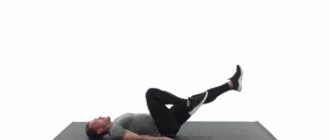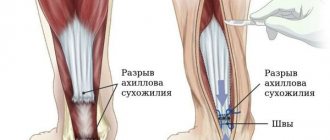Many beginners do not always even know that the program needs to be changed during training. Most people not initiated into the topic of bodybuilding believe that it is enough to develop a program only once and then follow it until the desired mass appears. But this is far from the truth, because the program should be changed.
Then the question arises, causing a lot of controversy - how often should you switch to a new program? There is real confusion here, because someone says that you need to add new exercises several times a month. On the other hand, they say that six months and no less, while others believe that 4 months is the optimal period. Therefore, now we will try to consider the issue from the scientific side.
Why change your training program at all?
Initially, you need to understand why the training is changing at all. This is far from a whim or an action for variety - without changing your training you will not achieve good results. But everyone’s goals are different:
- increase in strength and endurance
- increase in muscle mass
- burning fat deposits
- increase in working weight
For all these points, you will need to switch to a new program over a certain period. And it's all about the fantastic adaptation of the human body. To make muscles grow (read more about how this happens here), you will need to create conditions that are unusual for them, to give them loads that they have not been able to cope with before. For strength training, the technique of constant progression of load comes first.
When you just start working with new weights or exercises, you can say “honeymoon” for muscle fibers. During this period, all the muscles of the beginning athlete actively react to the load and change their characteristics (endurance, strength or other aspects, which depends on the type of training).
When the conditional 30 days are over, the muscles again need to be surprised with something new. This could be increasing the number of sets, reps or weights. Various training principles (superset, pyramid and the like) will also be useful here. But here another question appears.
How long does it take for the body to adapt to stress?
The human body is amazingly tuned and able to quickly adapt to new conditions. It only takes 21 days for the brain to turn a daily activity into a habit. As for the muscles, they generally adjust to a new job after several workouts.
An example of such an adaptation would be a situation where an athlete performs a new exercise and the next day moves with difficulty. But after 2-3 workouts, this effect is no longer there; gradually the result of the training is not so physically noticeable. Therefore, the first 2-4 weeks are the most difficult for muscle tissue, when muscles are actively changing. Already at 5-8 weeks the effect slowly decreases, but from 9-12 weeks the muscle simply does not respond to the ongoing training. And this is where you need to create a new stressful situation. If you examine the result on the graph, it looks like this:
It should be borne in mind that this graph and the numbers mentioned are taken from average statistical indicators and can change individually. It all depends on the “starting point”, that is, the degree of training of a person. If we talk only about beginners with up to 1 year of experience, then the numbers are growing, because adaptation is slower due to the poorly developed muscle-brain connection. Therefore, here the process of muscle growth is somewhat extended, for beginners the norm will be 10-16 weeks, only during this period you need to think about changing the training program.
On our website, professional trainers have compiled many training programs for various purposes. A convenient filter system, as well as a unique ability to edit any workout to suit your needs! Go to the training section and select a training program for free!
If we are talking about experienced athletes who fully feel their body and are familiar with pumping and the difference between types of muscle contractions, then they can reduce the intervals to 4-6 weeks of work with an unchanged program. Now let’s look at the recommended periods of work with one PT depending on the level of fitness:
- beginner: 2.5-4.5 months (10-16 weeks)
- average: 2-3 months (8-11 weeks)
- professional: 1-1.5 months (4-6 weeks)
Many people turn to the issue of changing the program only during strength training. But those who use exclusively aerobic exercises (cardio) also need to change it. Here, too, without changing exercises, the body quickly finds a less energy-consuming activity option. Therefore, the weight loss process may stop due to adaptation.
After just 1-2 months on the treadmill, the body will require fewer calories for races. This is all due to the adjustment of all participating processes towards reducing energy consumption. For maximum efficiency, it is recommended to promptly change the loads week by week:
- 1-3 – swimming
- 4-7 – jump rope
- 8-11 – sprint
By the way, many scientists claim that the muscles fully adapt to the loads by the fourth workout. This means that from the 5th workout, the quality response to the load begins to fall. And the further you go, the more noticeable is the decrease in the effectiveness of training.
Frequency of changes
Regularly changing exercises is the key to progress.
Based on the human body’s adaptation to stress, the need to periodically change the training program is obvious. The main issue here becomes the frequency of changes. The following points of view are common:
- change of program after 6-8 weeks;
- making changes to the training program after 3-4 months;
- changes in the training process every 4 months or six months.
This difference in time frames is due to the individual characteristics of the body and the level of training of the athlete. The first weeks (2-4 weeks) are considered the most stressful. During this period, active muscle changes occur. At the next stage (5-8 weeks) the decline phase begins - decreasing returns from the training process. After week 8, further muscle development requires setting tasks that differ from the usual loads.
The muscular system of beginners at the initial stage of training is characterized by weak neuromuscular connections, the formation of which has just begun. In experienced and professional athletes, muscles adapt to loads much faster. This determines the shorter period of effective operation of the new program.
The determining factor in changing the training regimen is precisely the effectiveness indicator - an increase in muscle mass or a decrease in the subcutaneous fat layer (depending on the tasks). If the effectiveness of training begins to decline, there is no progressive increase in muscle mass, or the subcutaneous fat layer stubbornly does not lose ground, it is time to think about changing the training program. At the same time, the new scheme should be goal-oriented - work on relief, weight loss, muscle growth, increased strength and endurance.
Why shouldn't you change your training programs often?
Again, the answer will be based on scientific research and conclusions. Many people say that frequently changing training programs is beneficial only because of the constant shock to the muscles. But physiologically it is impossible to shock muscle tissue, because it is completely passive.
If you are not confident in your abilities in drawing up training programs, then the best way would be to turn to professionals! On our website you can order a training plan from professionals taking into account your goals, body characteristics and lifestyle. Receive all necessary comments and support within a month according to the compiled program. Find your coach here
Each exercise has its own schedule for adaptation of the nervous system, which is the reason for the decrease in the effectiveness of the program. Each exercise has its own period of adaptation for the body, because the simplest exercise will become ineffective in just a few weeks, but more complex loads give an effect for several months. Examples include deadlifts and barbell curls. The first exercise will take longer to master by the nervous system, but the second is much faster.
If we take a closer look at the theory of nervous adaptation, then initially there is practically no muscle growth. Only when the nervous system adapts to a new exercise does muscle tissue begin to grow. This is called overcoming a “nervous plateau,” but it should not be viewed as stagnation. Scientists compiled a schedule back in 1988 (Med Sci Sports Exerc., “Neural adaptation to resistance training”).
According to these data, the process of creating the correct neural changes (connection between nerve endings and muscles) lasts 8-20 weeks. Only after this does active growth of muscle tissue begin.
According to the study text, improvements in muscle growth along with strength are associated only with the ability of the nervous system to recruit more muscles to work. Strength training provokes changes in the nervous system, adapting to new loads, which then gives it the ability to better coordinate movements and use more muscles for a certain action. And this causes an increase in net force in a certain direction. As a result, strength increases not because of the growth of muscle tissue, but because of better coordination of their work.
And from this we can already conclude that the planned 4-6 weeks for one program simply does not allow the body to fully use all the muscles. It turns out that strong neuromuscular connections are just beginning to be created, and the athlete changes the training program and, accordingly, the amount of load.
It is also important to include 2-3 basic exercises for a specific muscle group in each workout. Then neural connections are formed better than when using single-joint exercises. Along with this there is one more point.
Change weight or training program?
As we have already found out, muscles are passive tissues and they do not care what program is currently used. Their destiny is to carry out commands from the central nervous system and nothing more; it will not be possible to deceive them separately from the nervous system. Muscle tissue can only contract and lengthen, nothing else is given. Therefore, only increasing the load can help in this regard.
Use a training diary to plan and record results. In order to comply with the principle of progressive load, you must constantly record your progress and plan your next workouts. Experts have created a convenient and functional training diary - see for yourself!
If you can add a little weight each workout (or through training), then you shouldn’t think about changing your training program just yet. That is, a progressive load allows you to stay longer at one PT. But many people don’t understand this and change exercises on the advice of a friend or a trendy program they see on the Internet. Although in reality, muscles can easily grow even after completing the previous program. At an advanced level, it is worth changing the program only when it is no longer possible to take on more weight. Only then should the athlete think about developing a new training program. Of the standard training schemes, many use the following principles (split training):
- each muscle group 1 time/week,
- each muscle group 2 times/week.
Regardless of this, you can work on one program for a long time and increase weight. And there will be progress, muscle growth will not stop. But when a gradual increase in working weights is no longer possible, then there is no way out and it is necessary to change the program.
At the same time, you cannot increase the number of calories in your diet as your weight increases. If every workout there is progress in the scales, then the number of calories should increase proportionally, otherwise there will be no weight gain. Read about nutrition for weight gain.
To summarize, there is no need to constantly disrupt muscle adaptation by changing the training program; you should definitely get everything that the selected exercises can give you.
Muscle habituation or frequent changes in training program
Why are you NOT making progress and why change your training program? Read about all this in the article “Muscle habituation or frequent changes in the training program”...
Recently, a friend of mine approached me with a request that I create an effective training program for him to gain muscle mass.
I became quite curious as to what was wrong with his current training program and why he was changing his training program so often lately. Lately, I've been noticing a lot of people in the gym who are constantly changing their training program like gloves. Relatively speaking, today they are doing one training program, and tomorrow they are doing another.
And such a change in training programs occurs almost every month, and for some even more often...
Of course, sometimes I myself like to do some new exercises for myself, but in no case do I change my program completely, but only slightly supplement it with some new exercises and see if they suit me or not.
But to constantly change my training program every month or every week, well, no, I'm a supporter of the old school and try to get the most out of each training program that I create for myself, and not jump from one program to another.
And even more so, if it has proven itself well and there are excellent results, then a logical question arises: why then does it need to be changed to another training program?!
In my opinion, it would be much better and more productive to work on improving the quality of the program itself rather than constantly changing it...
When I asked my friend, what’s wrong with his training program and why do you need to change anything?
Then he replied that he had already been doing his training program for the second month and it seemed that at first he had some kind of result, but now for a couple of weeks there was no result at all.
And he asked me why this is happening?
And why did he previously manage to progress with his training program at first, but now he simply has no results at all and no progress. Like, what could be the reason and how can he fix it?
I tried to explain to him the main root reason why many athletes, starting to engage in some kind of program, simply stop progressing in it after some time.
For some reason, many athletes are confident that the main reason that they suddenly suddenly stopped progressing is that supposedly their muscles tend to get used to the same exercises.
Therefore, in order to constantly progress, they need to constantly change all their exercises by rearranging them or adding some new exercises to their program or changing it completely. Allegedly, this is necessary in order to somehow shock your muscles and give them new stress, and therefore a new impetus for muscle growth.
In fact, this is just a crazy theory, which to this day lives in the heads of many athletes and does not want to fade away.
The real reason why an athlete suddenly suddenly stops progressing in their training is that in your training you are simply creating insufficient muscle stress for further muscle growth.
It is for this simple reason that you have no progress and no muscle growth, and not because your muscles are again accustomed to some of your next training programs.
In fact, there is NO muscle adaptation to any training program or to any exercise. Habituation, or as it is also called, muscle adaptation occurs not to the exercises, but to the load with which you work.
There is only high intensity and low intensity - high muscle stress followed by muscle growth and low muscle stress after which nothing happens.
At the same time, muscle stress itself is well measured in the form of your applied intensity, which will be directed to a particular muscle group.
As soon as you slightly increase the load and intensity of your exercises and training in general, you will immediately begin to progress again.
Therefore, there is no addiction and never has been!
If you take any muscle group and calculate the load and intensity throughout the training cycle, then you will immediately see where and in which of your workouts you experienced changes in the form of an increase and decrease in your overall intensity coefficient.
You will immediately understand where you had high intensity after which your muscles began to grow, and where you had low intensity after which there was no muscle growth.
Therefore, I answered my friend that it would not be logical to constantly change your training program, but it would be much more logical if you first understand the root cause and understand why everything happens this way.
Based on all this, I can safely say that the myth about some kind of muscle addiction and constant change of the training program is just a myth...
When is it necessary to change the program?
In fact, there are 3 main reasons that require a mandatory change to the existing training program.
- Life circumstances . Often life is not built around the gym, but the gym is introduced into the living conditions. If in their youth many people can go to the gym at least every day, then later each person starts a family, begins to build a career and raise children. Then you have to adjust the program taking into account free time.
- Changing the goal . If initially it was necessary to increase muscle mass, and only then it was necessary to remove fat and give relief to the forms, then physically you cannot do without changing the program.
- Boredom . When training stops making you happy and enjoyable, something needs to be changed. Usually the signal is going to the gym “on autopilot” with zero motivation. An excellent option to increase interest in training is to change the program.
The main reasons why many people change their training program
Not everyone asks this question: how often should you change your usual training program? For those who have been involved in sports for many years, it is not difficult and they can change it without any reason. Usually a person himself understands when he needs to change it. After all, life does not stand still, something changes, something gets boring. For those who cannot decide for themselves whether to change or not, below are the reasons when you definitely need to do this:
Target
A person who goes in for sports always pursues a specific goal (lose weight, get pumped up, become stronger, etc.). And the chosen program does not always turn out to be correct and effective.
In this case, you need not to waste time and effort, but immediately change the entire program.
And when creating a new program and choosing exercises, it is worth consulting with someone who is well versed in this area. Since if the second program is not correct, then over time the person will simply lose interest and forget his goal.
About the plateau effect during training >>
Lifestyle change
This is also the most common reason why most people change their training plan. Most often, a person’s work schedule changes and there is very little time left for training. In this case, most people switch to home training, since such training takes less time.
And if sports equipment is needed to perform some exercises, then they are simply replaced with those that do not require anything to perform. It rarely happens when the amount of free time increases, but if so, then the program can be a little more complicated.
Monotony
A person always wants something new, and this also applies to training. Since constant, identical exercises become boring over time. And when this happens, a person loses enthusiasm, the exercises are performed carelessly, purely automatically. A workout that isn't fun will never be beneficial. Therefore, if the exercises begin to get boring, it is better to replace them immediately.
A person has a huge choice; there are many exercises for all muscle groups, which can be alternated from time to time, and sometimes new ones can be added.
Health problems
If problems arise, you must immediately stop all training and undergo a medical examination. Because health is not something to joke about, and minor injuries can have serious consequences. If no problems are found, then you should simply replace the plan. If an injury is discovered, then a training plan should be drawn up only together with a specialist. It is not permissible to continue exercising if you have health problems.
This is not a complete list of reasons why the program needs to be changed, there are many of them. Since each person is individual, which for some is a very drastic reason, for others it is insignificant.
Based on all of the above, the following conclusion follows: you cannot constantly study according to one plan, but at the same time you should not change it too often. In both cases there will be no result. Everything needs to be done in due time, this is the only way to achieve your goal.
Usually a person himself feels that it is time, that something needs to be changed. If an athlete is a beginner and cannot understand whether it is necessary or not, then he must analyze the following: what he has achieved, whether the bar is being raised, whether there is a result. If there really is a result, then you need to continue using this plan.
If development has slowed down or stopped altogether, it means that it’s time to change something. Or if classes don’t bring you joy, then change everything too. In a person’s life, not only in sports, something must sometimes change. Otherwise, over time, the routine will drag on and everything will get boring, life will seem monotonous and boring. And in order to avoid this and enjoy life, you must always try something new, unusual, and then life will always be full of joy.
The result of changing the training program
It is hoped that all the information was completely clear and showed the basic principle of changing the program. Now it is clear that the central nervous system cannot adjust in 4 weeks, but requires a minimum of 8 weeks. And it’s clear that the numbers are different for everyone, because a beginner can work with one program for 4 months, progressing, but a professional will find 6 weeks a lot.
Therefore, we are trying to establish an optimal neural connection and get the maximum from the program we use. And only then we consider how it can be improved and modified to transition the muscle plateau. We use the described methods in practice and become closer to our goal - a beautiful, sculpted body.











